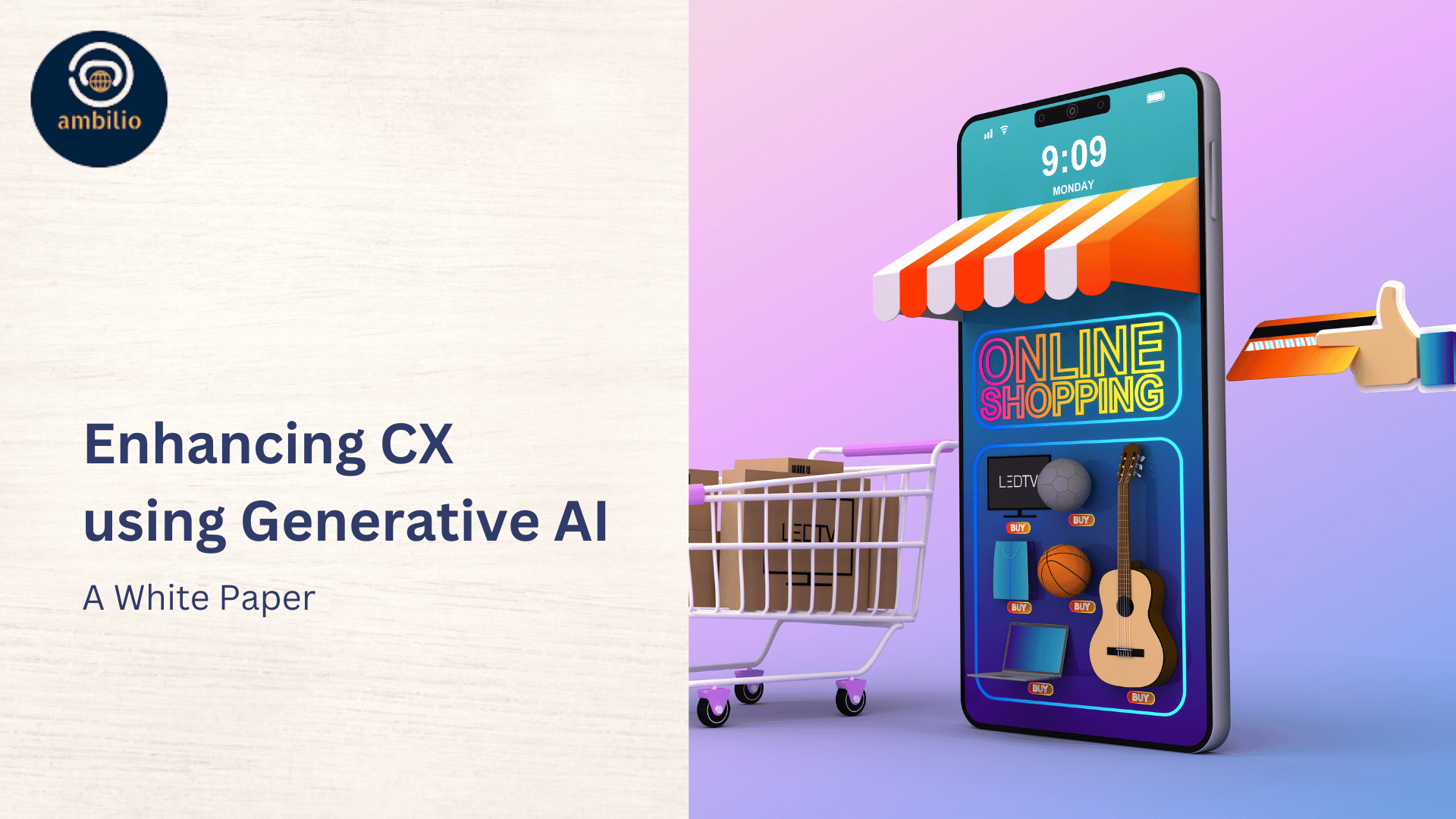In recent years, e-commerce has become an integral part of our daily lives, revolutionizing the way we shop and interact with businesses. With the increasing popularity of online shopping, providing an exceptional customer experience has become more important than ever for e-commerce companies. In fact, according to a report by PwC, 86% of customers are willing to pay more for a better customer experience.
One promising approach to enhance customer experience in e-commerce is through the use of generative AI, specifically GPT and Latent Diffusion Models. These models can help e-commerce companies better understand customer preferences, personalize recommendations, and streamline the shopping experience. By leveraging the power of generative AI, e-commerce companies can create more engaging and personalized experiences for their customers, leading to increased customer satisfaction, loyalty, and revenue.
In this white paper, we will explore how e-commerce companies can use generative AI to enhance customer experience, the benefits and challenges of using these models, and case studies of companies that have successfully implemented them. We will also discuss the future of generative AI in e-commerce and its potential to transform the industry.
Table of Contents
- Introduction to e-commerce and the importance of customer experience
- Overview of generative AI and its applications in e-commerce
- Explanation of GPT and Latent Diffusion Models and how they can enhance customer experience
- Benefits of using generative AI in e-commerce, including improved customer engagement, personalization, and recommendations
- Challenges of implementing generative AI in e-commerce, such as data quality and privacy concerns
- Case studies of e-commerce companies that have successfully used generative AI to improve customer experience
- Future of generative AI in e-commerce, including emerging trends and technologies
- Best practices for implementing generative AI in e-commerce to enhance customer experience
- Conclusion and key takeaways for e-commerce businesses looking to leverage generative AI for customer experience enhancement.
Introduction to e-commerce and the importance of customer experience
E-commerce, or electronic commerce, refers to the buying and selling of goods and services online. It has become a rapidly growing industry over the past few decades, and it is now an essential part of the modern economy. E-commerce has revolutionized the way people shop, enabling them to make purchases from anywhere in the world, at any time of day, with just a few clicks of a button.
One of the most critical aspects of e-commerce is the customer experience. In a traditional brick-and-mortar store, the customer experience is often determined by the physical environment, such as the layout, lighting, and ambiance of the store. However, in e-commerce, the customer experience is largely determined by the design of the website, the quality of the products, and the ease of the purchasing process.
The importance of customer experience in e-commerce cannot be overstated. Customers have a plethora of options to choose from, and they are more likely to return to a site where they had a positive experience. On the other hand, a poor customer experience can lead to negative reviews, lost sales, and damage to the brand’s reputation.
To create a positive customer experience in e-commerce, businesses need to focus on several key factors. Firstly, the website must be well-designed and user-friendly, with a clear and easy-to-navigate layout. Secondly, the product descriptions and images must be accurate and high-quality, giving customers a clear idea of what they are buying. Thirdly, the purchasing process must be smooth and hassle-free, with options for easy payment and fast delivery.
In addition to these factors, businesses need to prioritize customer service and support. Customers may have questions or concerns about products or the purchasing process, and they expect quick and helpful responses from the business. Providing excellent customer service can build trust and loyalty, leading to repeat business and positive word-of-mouth recommendations.
Overview of generative AI and its applications in e-commerce
Generative AI, also known as generative models, is a branch of artificial intelligence that involves creating algorithms that can generate new data or content. It is different from traditional AI, which focuses on analyzing and processing existing data.
Generative AI works by learning patterns and structures from a dataset and then generating new data that follows those patterns. It can be used for a variety of applications, including image and text generation, music composition, and even video game design.
In the context of e-commerce, generative AI has several potential applications. One of the most significant is in the area of personalized product recommendations. E-commerce platforms can use generative AI algorithms to analyze a customer’s browsing and purchase history and generate personalized product recommendations based on that data.
Another potential application is in the area of product design. Generative AI algorithms can be used to generate new product designs based on a set of criteria, such as customer preferences or design constraints. This can help e-commerce businesses create new products more efficiently and effectively.
Generative AI can also be used to generate product descriptions, product images, and even product reviews. For example, an e-commerce platform could use a generative AI algorithm to create unique product descriptions for each item in their catalog. This could help them stand out from competitors and improve search engine optimization (SEO) rankings.
Finally, generative AI can be used to generate chatbots and virtual assistants that can assist customers with their shopping experience. These chatbots could provide personalized recommendations, answer questions about products and services, and even help customers with their purchases.
Explanation of GPT and Latent Diffusion Models and how they can enhance customer experience
GPT and Latent Diffusion Models are two types of machine learning models that have the potential to enhance customer experience in different ways.
GPT (Generative Pre-trained Transformer) is a type of language model that has been pre-trained on large amounts of text data to predict the next word in a sentence. It is capable of generating human-like language, which makes it useful for a variety of natural language processing (NLP) tasks, such as language translation, text summarization, and chatbots. GPT can enhance customer experience by providing personalized and relevant responses to customer inquiries and feedback, thereby improving customer satisfaction and loyalty. For example, a chatbot powered by GPT can understand customer queries in natural language and provide intelligent responses that address the customer’s specific needs.
On the other hand, Latent Diffusion Models (LDMs) are generative models that use a series of diffusion steps to model complex data distributions. They are particularly useful for image and video processing tasks and can be used to generate realistic and high-quality images and videos. LDMs can enhance customer experience by enabling businesses to create personalized and engaging visual content that resonates with their customers. For example, a fashion retailer could use LDMs to generate realistic images of customers wearing their clothes, which can be used to provide a more immersive and personalized shopping experience.
In summary, GPT and LDMs are two types of machine learning models that have the potential to enhance customer experience by providing personalized and relevant responses and creating engaging visual content, respectively. By leveraging the power of these models, businesses can improve customer satisfaction and loyalty, which can ultimately drive growth and success.
Benefits of using generative AI in e-commerce
Generative AI, including GPT and Latent Diffusion Models, can bring a range of benefits to e-commerce businesses, including improved customer engagement, personalization, and recommendations.
- Improved Customer Engagement: GPT can be used to create conversational interfaces, such as chatbots, that can interact with customers in natural language. This can enhance customer engagement by providing a more personalized and interactive experience. GPT can also be used to generate personalized product descriptions and reviews, which can help customers make more informed purchase decisions.
- Personalization: GPT and LDMs can be used to create personalized product recommendations and advertisements based on a customer’s browsing and purchase history. By analyzing customer data, these models can generate recommendations that are more relevant and personalized, which can increase the likelihood of a customer making a purchase.
- Enhanced Product Visualization: LDMs can be used to generate realistic product images and videos, which can help customers visualize the product in a more immersive and engaging way. This can improve the customer’s overall shopping experience and increase the likelihood of a purchase.
- Reduced Costs: GPT can be used to automate customer service tasks, such as answering frequently asked questions or addressing common issues, which can reduce the need for human support staff. This can save businesses time and money while also providing customers with a more efficient and responsive support experience.
- Improved Sales and Revenue: By providing personalized recommendations and engaging visual content, businesses can increase the likelihood of a customer making a purchase. This can lead to increased sales and revenue for the business.
In summary, generative AI, including GPT and LDMs, can bring a range of benefits to e-commerce businesses, including improved customer engagement, personalization, and recommendations, enhanced product visualization, reduced costs, and improved sales and revenue. By leveraging these technologies, e-commerce businesses can gain a competitive edge and improve customer satisfaction and loyalty.
Challenges of implementing generative AI in e-commerce, such as data quality and privacy concerns
While generative AI can bring a range of benefits to e-commerce businesses, there are also several challenges associated with implementing these technologies. Some of the key challenges include:
- Data Quality: Generative AI models rely on large amounts of data to learn and generate high-quality outputs. However, data quality can be a challenge in e-commerce, as product data may be inconsistent or incomplete. This can impact the accuracy and effectiveness of generative AI models.
- Privacy Concerns: E-commerce businesses must ensure that customer data is protected and handled in compliance with data privacy regulations. Generative AI models may require access to sensitive customer data, such as browsing and purchase history, which can raise privacy concerns.
- Complexity: Implementing generative AI in e-commerce requires a high degree of technical expertise, as well as significant time and resources. Businesses may need to hire specialized data scientists or machine learning engineers to develop and deploy these models.
- Bias: Generative AI models may replicate and amplify biases present in the training data, leading to unfair or discriminatory outcomes. E-commerce businesses must take steps to identify and mitigate these biases to ensure that their models are fair and unbiased.
- Integration: Integrating generative AI models with existing e-commerce platforms and systems can be a complex and time-consuming process. Businesses may need to invest in new infrastructure or modify existing systems to support these models.
In summary, while generative AI can bring significant benefits to e-commerce businesses, there are several challenges that must be addressed. These include data quality, privacy concerns, complexity, bias, and integration. E-commerce businesses must carefully consider these challenges and develop strategies to overcome them in order to successfully implement generative AI and realize its full potential.
Case studies of e-commerce companies that have successfully used generative AI to improve customer experience
There are several e-commerce companies that have successfully used generative AI to improve customer experience. Here are a few examples:
Stitch Fix
Stitch Fix, an online personal styling service, uses machine learning algorithms to generate personalized clothing recommendations for its customers. The algorithms take into account a customer’s personal style preferences, body type, and budget to generate a set of clothing items that the customer is likely to love. The company’s use of generative AI has been a key factor in its success, helping it to generate more than $1 billion in revenue in 2020.
Adidas
Adidas, a global sportswear brand, uses generative AI to create personalized product recommendations for its customers. The company’s AI platform analyzes customer data, including purchase history and browsing behavior, to generate personalized recommendations for products that are likely to appeal to the customer. The platform has helped Adidas to increase sales and improve customer satisfaction.
Ikea
Ikea, a global furniture retailer, uses augmented reality (AR) technology powered by generative AI to allow customers to visualize furniture in their homes before making a purchase. The company’s AR app uses computer vision and machine learning to generate a realistic 3D model of the furniture, which can be placed in the customer’s home using the camera on their smartphone. The app has been well-received by customers and has helped to increase online sales.
ASOS
ASOS, an online fashion retailer, uses generative AI to generate personalized product recommendations for its customers. The company’s AI platform analyzes customer data, including purchase history, browsing behavior, and social media activity, to generate recommendations that are tailored to the customer’s style preferences. The platform has helped ASOS to increase sales and improve customer engagement.
In summary, several e-commerce companies have successfully used generative AI to improve customer experience, including Stitch Fix, Adidas, Ikea, and ASOS. These companies have leveraged the power of generative AI to provide personalized recommendations, enhance product visualization, and improve customer engagement, ultimately driving growth and success.
Future of generative AI in e-commerce
Here are some potential advanced future applications of generative AI in e-commerce.
Predictive Inventory Management
Generative AI has the potential to transform inventory management in e-commerce by enabling businesses to predict demand for products more accurately. This could help to reduce waste and optimize supply chain efficiency.
Hyper-Personalization
The use of generative AI in e-commerce could lead to a more hyper-personalized shopping experience for customers. By analyzing data on customer behavior, preferences, and history, generative AI could help businesses offer highly tailored product recommendations, personalized pricing, and even personalized marketing messages.
Voice-Enabled Shopping
The use of voice assistants powered by generative AI could make shopping more convenient and accessible for customers. By enabling customers to shop using voice commands, businesses could create a more seamless and frictionless shopping experience.
Sustainable Product Design
Generative AI has the potential to help e-commerce businesses design more sustainable products by analyzing data on materials, manufacturing processes, and environmental impact. This could help to reduce waste and improve the overall sustainability of the industry.
Best practices for implementing generative AI in e-commerce
Here are some best practices for implementing generative AI in e-commerce to enhance customer experience.
- Define clear goals: Before implementing generative AI, it’s important to define clear goals and metrics for success. This could include increasing sales, improving customer satisfaction, or reducing operational costs. By defining clear goals, businesses can ensure that their use of generative AI is aligned with their overall strategy.
- Use high-quality data: The quality of the data used to train generative AI models is critical to their success. It’s important to use high-quality data that is relevant to the business and representative of the customer base.
- Ensure transparency: Customers may be hesitant to use generative AI-powered tools if they don’t understand how they work. It’s important to ensure transparency in the use of generative AI and to provide clear explanations of how it is being used to enhance the customer experience.
- Prioritize privacy: Privacy concerns are a key consideration when implementing generative AI in e-commerce. Businesses must ensure that they are collecting and using customer data in a responsible and ethical manner, and that they are complying with relevant regulations.
- Continuously monitor and improve: Generative AI models require ongoing monitoring and refinement to ensure that they are performing effectively. It’s important to regularly review and analyze the results of generative AI-powered tools, and to make adjustments as needed to ensure that they are delivering the desired outcomes.
By following these best practices, businesses can effectively implement generative AI in e-commerce to enhance the customer experience and drive business success.
Conclusion and key takeaways
In conclusion, generative AI has the potential to transform the e-commerce industry by enhancing the customer experience, improving personalization, and increasing sales. However, businesses must be mindful of the challenges associated with implementing generative AI, such as data quality and privacy concerns. To successfully leverage generative AI for customer experience enhancement, e-commerce businesses should:
- Define clear goals for the use of generative AI
- Use high-quality data to train generative AI models
- Ensure transparency in the use of generative AI-powered tools
- Prioritize customer privacy and comply with relevant regulations
- Continuously monitor and refine generative AI models
By following these best practices, e-commerce businesses can effectively leverage generative AI to create a more personalized and engaging shopping experience for their customers. Ultimately, this can lead to increased customer loyalty and sales, and a stronger competitive position in the marketplace.



